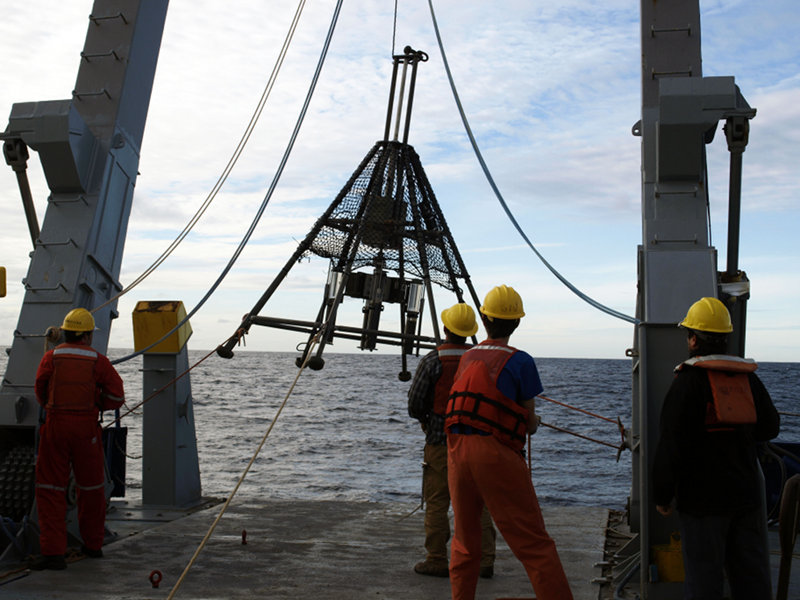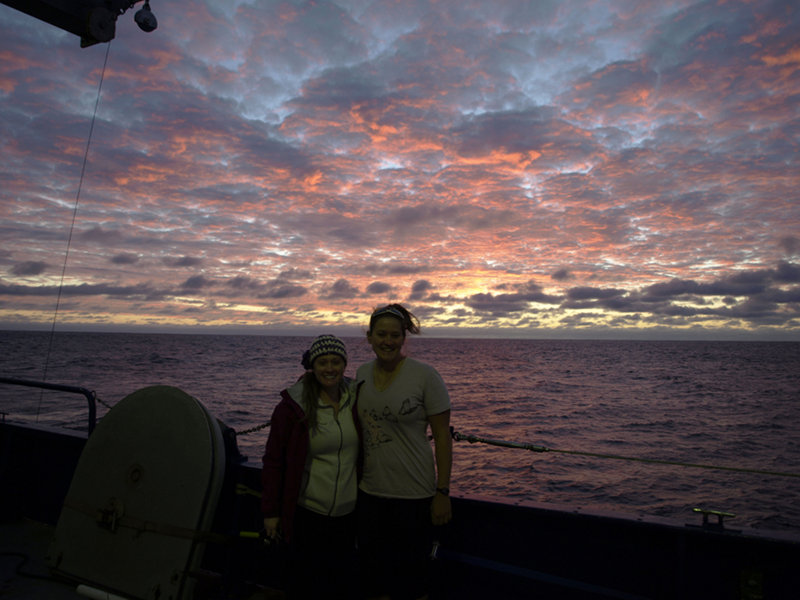
By Chris German, Woods Hole Oceanographic Institution
April 26, 2012

Javier, Keith, Ben and Eulogoio bring the precious sediment samples from the multi-corer safely on board. I then stand safely back as a stampede of sample-hungry biologists descend on the back deck to set to work in a flurry of activity. Image courtesy of Chris German, INSPIRE: Chile Margin 2012 Expedition, NOAA-OER. Download larger version (jpg, 1.0 MB).
What a day! As I went to bed at 3 am Thursday morning, we had 24 hours left and counting. Time to sleep fast!
TowCam worked through the night, brought up some first wonderful 16MPix photos from the seafloor and even collected is first biological sampling by slurping an animal up with a hose suspended beneath the sled.
By morning, Donna was already running through multiple parallel-universe options on how the last 18 hours would be spent on site, only to learn that weather forecasts for what was happening ahead meant that may be only 16 hours. But then, late in the afternoon, it was relaxed to 17 hours.
One major question for the the day was where to send the last long CTD tow. We did a quick dip of the CTD over the site where Andrew, Lisa, et al. found the hot sediments in 2010 to collect water samples for Marv to measure and then – SUCCESS!! At the fifth attempt, we sent the multi-corer down to the seafloor and it came back up with our first sediment core samples of the cruise – time for a biological sampling frenzy!
As soon as that came on deck it was decision time for the final CTD cast – do we go southwest or northeast? “Give me 15 minutes,” said Marv. An injection of sample, a bleep from the GC, and a plot rolled out across the screen of Marv’s computer. “This is lower than yesterday, go north.”

A quiet 30-second moment in the middle of our final CTD cast. Marv and Ko-ichi kindly look after the CTD for a few moments as Ashlee (left), Rachel, and I shoot out on deck, admire this spectacular sunset and then head back inside again. Image courtesy of Chris German, INSPIRE: Chile Margin 2012 Expedition, NOAA-OER. Download larger version (jpg, 875 KB).
Into the water and down to where we hit the strongest methane concentrations yet and then off for a final tow, about a quarter mile northeast, straight toward the cliffs. Funnily enough, sometimes it is less hectic when you are in the water and working (but you have been doing this for years and it comes as second nature) than in between when your brain is racing, trying to interpret all the data flying at you and wary that a single simple slip in logic or interpretation will send you the wrong way.
While the CTD is between waypoints and transiting at a safe height above the seafloor, I have time to catch up with Carl and Dana who have been looking through the sonar data from the first Sentry dive and locating new targets. Donna calls a science meeting to help use this information, on top of everything else, to decide where the final TowCam will go and soon the CTD is on its way up. I am out on deck with Ron and Marv, collecting our final water samples, as TowCam heads over the side and down to the seafloor while alongside me. About 10 meters off on the side of the ship, a pair of seals are frolicking in the glow of the ship’s lights in an otherwise inky-black ocean. How come they aren’t totally stressed out at this point???
By the time I get back inside, both Sentry and TowCam were working in adjacent parts of the seafloor. Ah yes, Sentry – it has been down on the seafloor for over 24 hours, quietly taking photographs where we asked it to and not causing any fuss. You could almost forget it was down there if you weren’t careful!
Around 11 pm, we realized that both Sentry and TowCam were arriving at the same place. As they came within 100-meters horizontal range of each other, the decision was made to pull TowCam up to 50 meters off bottom as Sentry swam by, coming within 38-meter horizontal range at its closest approach. TowCam has one hour left on-bottom and Sentry has to come back an hour later.
Dana and Carl quickly calculated the commands required and re-programmed Sentry via acoustic signals to move 100 meters to the east for the next hour. Once TowCam has left bottom and is safely out of the way, they send the commands to move Sentry back. But the ship is pointing the wrong direction and the command doesn’t get through for 15 minutes, by which time it will take another 15 min to get back; we just lost half of our remaining hour of final data. OK, time to re-program Sentry one more time and just aim for three, 10-minute survey lines, not five. Sentry arrives in the right place at 12:40 am.
Captain Dave arrives to make sure all is wrapping up in an orderly fashion and Donna invites him to afford us an extra 30 minutes to complete the western half of the planned final survey. We can’t risk it, we need to head for port, but with the time remaining, we’ll only have time for two of those three lines and will end up with a coverage in our data. We make big eyes at the Captain (think Puss from the Shrek movies) and ask for 10 minutes more. His heart melts (allegedly) and gives us the OK. Phew. Sentry heads down the second line as 1 am passes and is most of the way up that final line we really wanted as 1:10 am comes around. We pull the plug, sending Sentry the “Abort Mission and Come Home” signal. By 1:11 am, we are able to radio the Bridge and confirm that Sentry is on its way home...